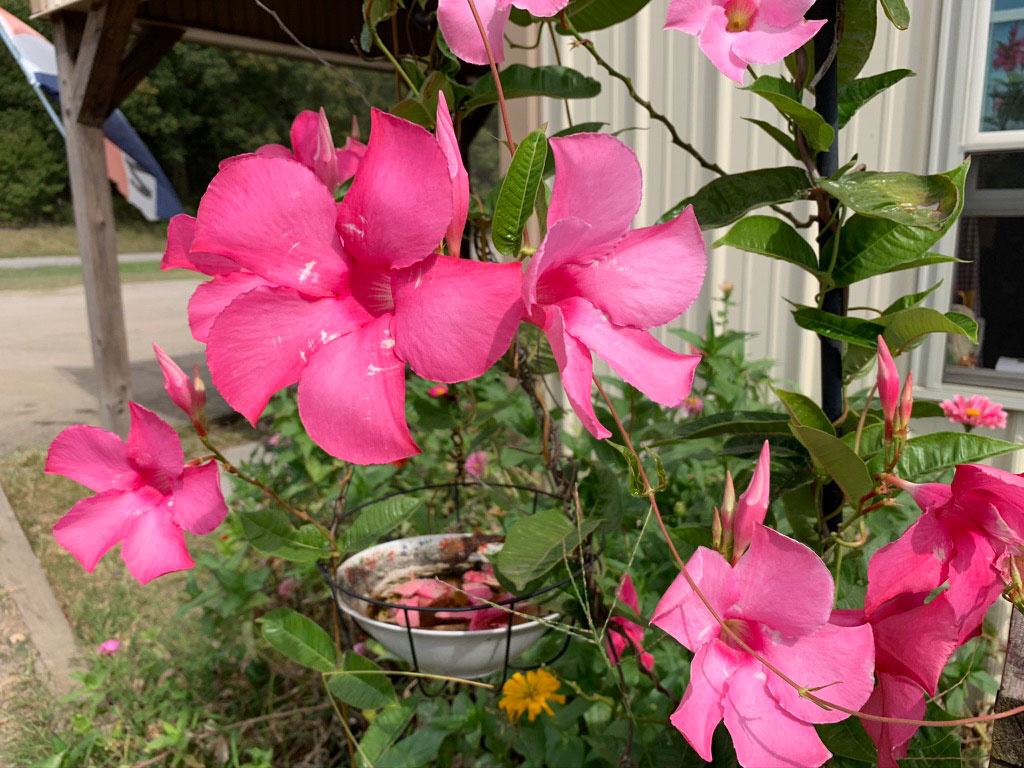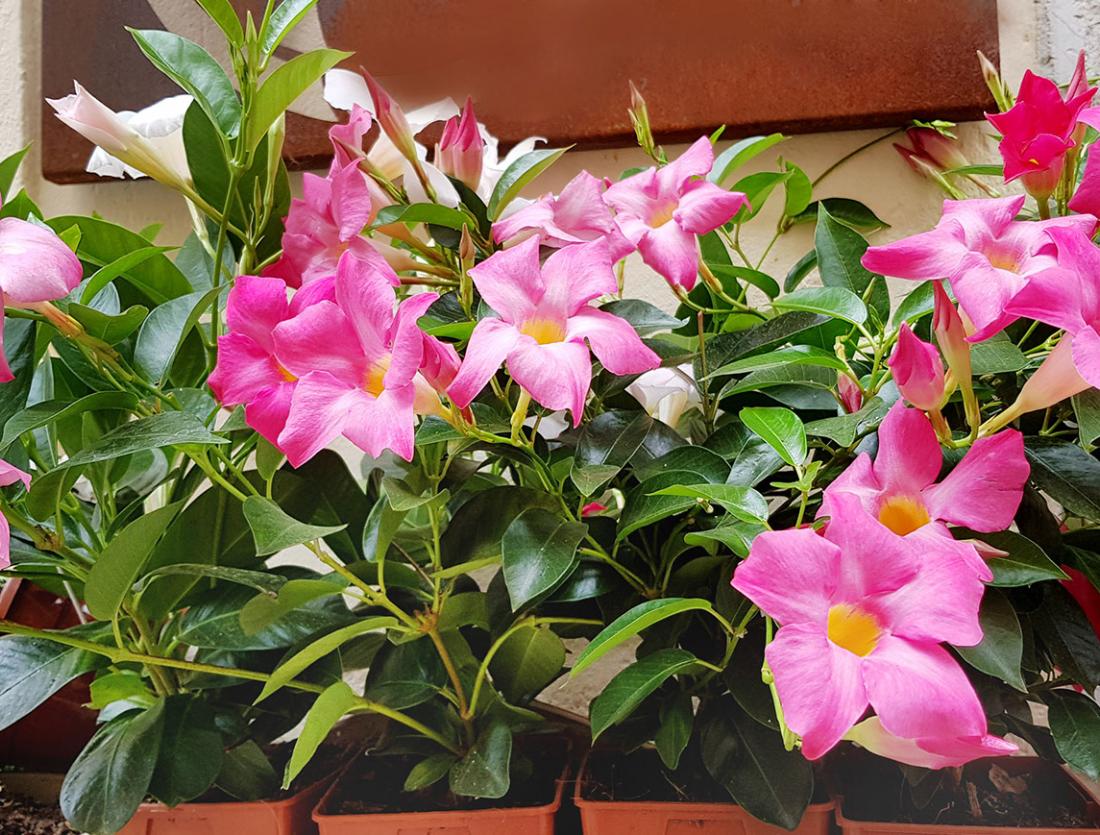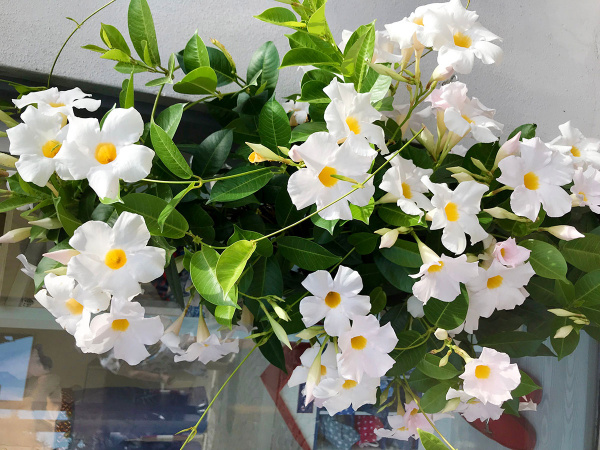How To Overwinter A Mandevilla Plant
Five Ways to Protect a Mandevilla Vine or Plant
The tropical Mandevilla plant is gorgeous with its gleaming leaves and multicolored blooms, but it must be overwintered to last through the years. How can you protect your precious Mandevilla?
Here are 5 ways to overwinter a Mandevilla plant or vine:
- Bring the entire plant into your home and grow it in a container.
- Shelter the entire vine in your home with a trellis or staking.
- Move your Mandevilla plant into a heated greenhouse.
- Take cuttings of the plant and bring them inside.
- Allow the Mandevilla plant to go dormant in a dark, cool space.
The most straightforward method of overwintering your Mandevilla is bringing the whole plant inside your home as the cooler month's approach. If you don’t have enough space in your living room, consider taking cuttings of the vine or allowing it to become dormant for a few months. Read below to determine how to execute each of the 5 overwintering methods without risking harm to your Mandevilla mound or vine.

1.) Grow it in a Container in the Home
The easiest way to overwinter your Mandevilla plant is to move the entire plant indoors. Plant it in a suitable container and move it to a patch of sun. You can explore containers for your Mandevilla mound here on Amazon.
Moving your entire Mandevilla mound indoors is ideal if you have sufficient space and a sunny window. This method is particularly easy if your plant is already growing in a container!
Here is how and when to move your Mandevilla plant into your home:
- When the temperatures dip below 50 degrees Fahrenheit, it’s time to take your Mandevilla inside.
- Prune your plant, even if you have enough space in your home for its current size.
- Check the plant for pests before moving it indoors – that’s the last thing you need. If you need to get rid of pests before relocating the Mandevilla, start with a strong jet of water from your garden hose. If that doesn't work, try out a pesticide or a Neem oil solution.
- Bring your plant inside and give it plenty of space in a sunny patch in your home.
- Keep your home thermostat in the 60s or low 70s for best results, at a maximum of 75 degrees Fahrenheit.
- Do not fertilize your plant during the first few months of winter – fertilization can weaken the stems at this time.
- Water the Mandevilla only when the soil appears dry.
- A few months before the weather warms up again (around February or March) prune your plant.
- In March, begin fertilizing the plant once per month to prepare it for optimal growth outdoors.
Here are a few other things you should know while you are overwintering your Mandevilla plant:
- Expect your plant to grow slowly throughout the winter.
- If you don’t have a sunny patch in your home, consider placing the plant under lights. Fluorescent, incandescent, and LED lights will all work.
- You should increase the humidity around the plant whenever possible to reduce leaf drop. Consider plugging in a humidifier nearby.
- Mandevilla plants tend to do better when the temperature drops slightly at night. You might want to lower your thermostat a few degrees in the evenings if you don’t already.
If moving the whole Mandevilla mound into your home for the winter doesn’t sound right for you, read on to learn about your other overwintering options.

Pink Mandevilla Plant
2.) Grow the Vine In-Home with a Trellis or Staking
Are you growing a mounding or vining Mandevilla? A container is perfect for a mounding Mandevilla, but vines may need to be held upright.
A mounding Mandevilla looks like an upright shrub, whereas the Mandevilla vine is a beautiful display on a trellis or garden wall. If you are growing a Mandevilla vine, you should probably move an upright structure into your home during the winter.
Set up a trellis, a window basket, staking, or any other upright structure to allow your vine to grow properly.
When the structure is ready, and the temperatures dip below 50 degrees Fahrenheit, follow the same directions given in the section above. First, prune your vine and check for pests. Then move your vine to your in-home structure, and keep it in a lighted spot between 60 and 75 degrees.
Decrease the temperatures at nighttime and water the vine when the soil appears dry. Don’t forget to prune your vine again in February or March, and begin fertilizing at this time.

3.) Move your Mandevilla into a Heated Greenhouse
Of course, you can use a heated greenhouse for full plants, vines, or trimmings of your Mandevilla.
If your greenhouse is above 60 degrees Fahrenheit, your Mandevilla will continue to grow and will not fall dormant. If you choose to relocate your plant or vine to a greenhouse, remember the following:
- Keep your plants on the dry side, but do not let them completely dry out; watch for dry-looking soil!
- Cut the vines down to 8-12 inches for best results
- Make sure your tropical plants receive enough light
- Trim the plant as much as needed to ensure it fits in the confines of the space
If you follow these directions, your tropical beauty will be ready to grow and blossom come springtime.
4.) Take Cuttings of the Mandevilla and Bring them Indoors
If you don’t have enough space to bring the entire plant into your home, consider taking small cuttings of the plant. You can either plant the cuttings in their own container or overwinter the smaller houseplants with the Mandevilla cuttings.
Here is how to overwinter Mandevilla cuttings:
- Wear garden gloves while cutting the Mandevilla back because the milky latex sap can be irritating to the skin.
- Investigate the vine for pests to ensure they don’t come into your home.
- Take 4-6" cuttings.
- Dip the cut end into a rooting hormone and then put it in potting mix or moist vermiculite.
- Plant the cuttings into a container and place it in the sunniest spot in your home.
Follow the advice given in the sections above regarding watering, temperature, and fertilization.
5.) Allow the Mandevilla to Go Dormant
Your fifth and final option for overwintering a Mandevilla plant is allowing it to ease into dormancy for a few months.
If you don’t have the right conditions for your Mandevilla plant or cuttings to overwinter indoors, letting your plant go dormant is a good option.
Don’t move the plant inside until the weather is cool, or when night temperatures hover around 50 degrees Fahrenheit. Then take the vine to a cold and dark place, like a garage, basement, or crawlspace. The temperature should be around 50-60 degrees Fahrenheit – well above freezing!
Prune your plant, check for pests, then move it to a container or trellis in the right environment. Water the Mandevilla only when it looks dry. In April, fertilize the plant. As soon as temperatures stay above 50 degrees F at night, you can move your Mandevilla back outside.
Here are a couple more tips if you choose to put your Mandevilla into dormancy:
- You can expect the plant to lose all of its leaves. Minimize leaf drop by pruning it extensively before bringing it into the basement or garage.
- In order to prevent rot root, cut back on watering significantly.
Tropical Mandevillas are absolute showstoppers with their impressive vines and beautiful blooms, and they spring back into life each year after being overwintered correctly!
Additional Information
New York Botanical Garden - Overwintering a Mandevilla Vine
Costa Farms - Winter Care for Mandevilla


